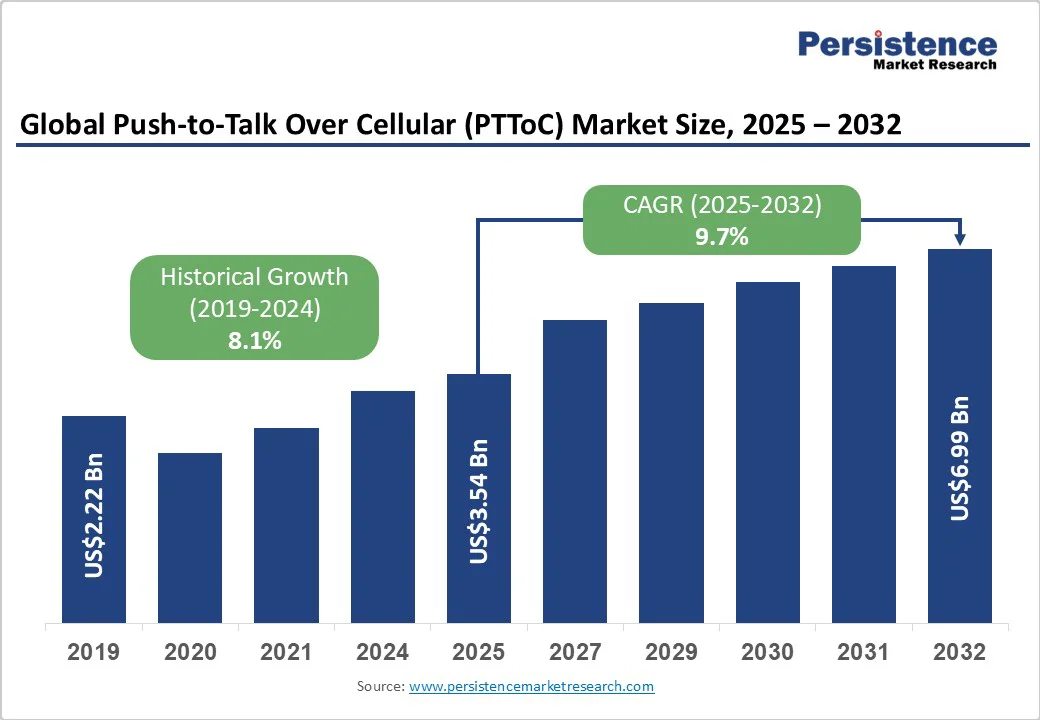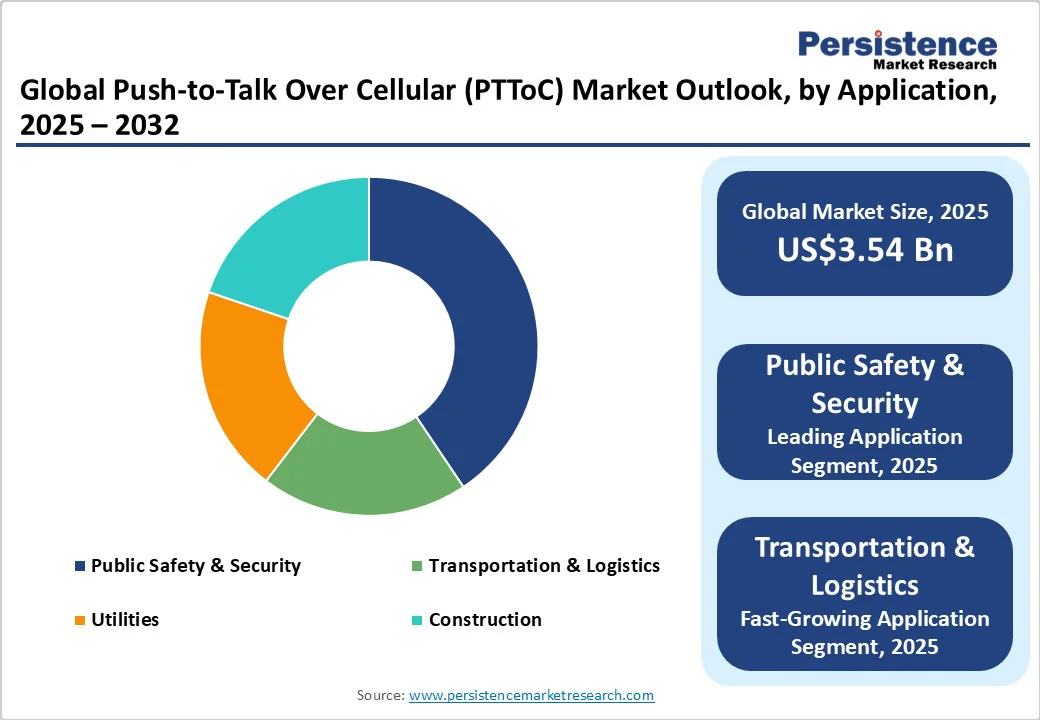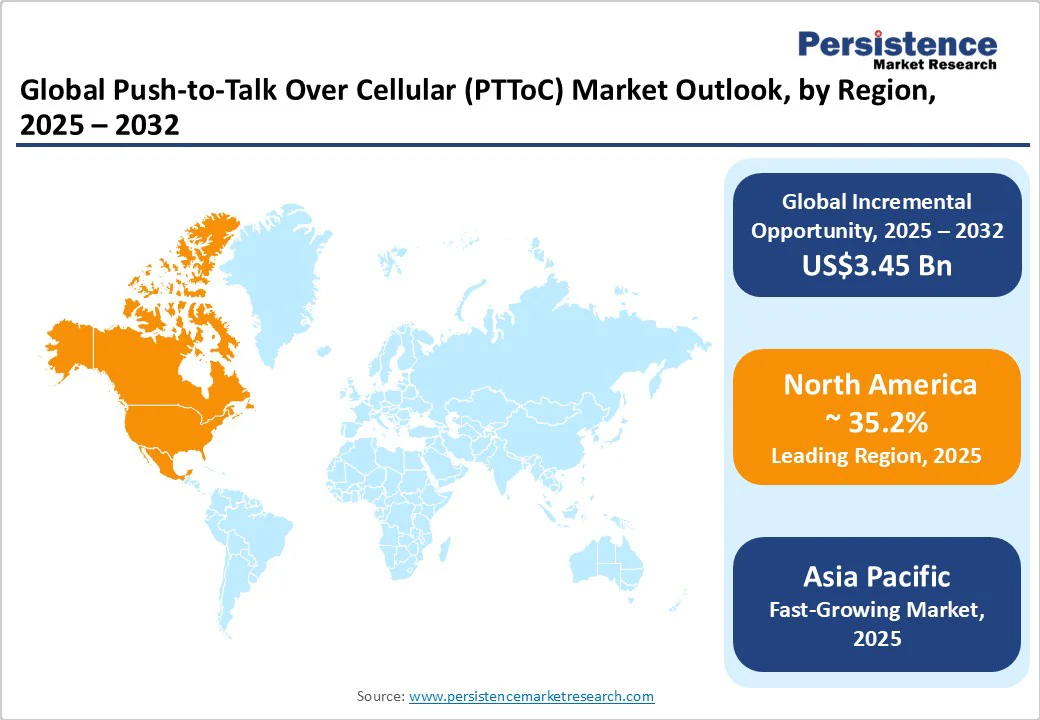ID: PMRREP17008| 220 Pages | 9 Oct 2025 | Format: PDF, Excel, PPT* | IT and Telecommunication

The global push-to-talk over cellular (PTToC) market size is likely to be valued at US$3.54 Billion in 2025 and is expected to reach US$6.99 Billion by 2032, growing at a CAGR of 9.7% during the forecast period from 2025 to 2032, driven by the increasing adoption of broadband-based communication solutions, rising demand for instant communication in mission-critical operations, and integration of 5G networks that enable low-latency and high-capacity services.
PTToC systems are gaining significant traction across industries such as public safety, transportation, logistics, and utilities, as organizations prioritize real-time, secure communication over traditional radio systems.
| Key Insights | Details |
|---|---|
| Push-to-Talk Over Cellular (PTToC) Market Size (2025E) | US$3.54 Bn |
| Market Value Forecast (2032F) | US$6.99 Bn |
| Projected Growth (CAGR 2025 to 2032) | 9.7% |
| Historical Market Growth (CAGR 2019 to 2024) | 8.1% |

The rising need for real-time communication in public safety, defense, and transportation sectors is a major driver of PTToC adoption. According to the U.S. Department of Homeland Security, emergency response agencies increasingly rely on LTE-based communication tools to enhance coordination and operational efficiency.
PTToC offers nationwide coverage, instant connectivity, and enhanced interoperability, replacing legacy systems such as Land Mobile Radio (LMR). The shift toward broadband-enabled voice and data transmission has strengthened the business case for PTToC systems, enabling faster deployment and lower operational costs for government and enterprise users.
The rollout of 5G networks globally is catalyzing PTToC growth by providing high bandwidth and ultra-low latency required for video, voice, and data communication in real time. According to GSMA Intelligence, by 2025, 5G will account for over 40% of mobile connections in advanced markets, creating a robust ecosystem for PTToC-enabled services.
Integration with IoT platforms and edge computing further enhances PTToC capabilities, enabling intelligent dispatching, live tracking, and AI-driven analytics. This technological synergy is transforming how enterprises manage mobile workforces and mission-critical field operations.
The transition from hardware-centric radio systems to cloud-hosted PTToC platforms is a defining trend. Enterprises are increasingly adopting subscription-based models that reduce capital expenditure and improve scalability. According to data from the International Telecommunication Union (ITU), cloud-based unified communication solutions have witnessed annual growth exceeding 25%.
Cloud PTToC enables cross-network connectivity (LTE, Wi-Fi, 5G) and multi-device interoperability, empowering organizations to manage communication seamlessly across geographies. This migration to cloud architecture underpins the long-term digital transformation of enterprise communication systems.
Unlike traditional radio systems that operate independently, PTToC relies heavily on cellular and broadband network coverage. In remote or rural areas with poor connectivity, communication latency and service disruptions can impede operational efficiency.
As per Ericsson’s Mobility Report, around 15% of global regions still lack reliable 4G/5G coverage, posing risks to mission-critical communication continuity. This network dependency remains a structural challenge for universal PTToC adoption.
Despite progress by 3GPP and OMA for PTToC standardization, interoperability among vendors and network operators remains limited. Enterprises using mixed infrastructures face challenges in integrating legacy LMR systems with broadband-based PTToC platforms.
This lack of harmonized standards raises deployment costs and restricts scalability across multi-agency operations. Until industry-wide frameworks mature, integration complexities will continue to hinder seamless adoption.
Governments across regions are modernizing their public safety networks by replacing traditional LMR systems with broadband-based PTToC solutions. The European Commission’s Broadband PPDR initiative and the U.S. FirstNet expansion are accelerating investments in next-generation communication infrastructure.
The public safety communication segment is projected to exceed US$8 Billion by 2032, presenting a significant revenue opportunity for PTToC vendors focusing on mission-critical services.
The global rise in distributed workforces has intensified the demand for instant communication tools integrated with mobile and wearable devices. Industries such as construction, logistics, and field services are deploying PTToC applications for seamless collaboration among mobile teams.
According to IDC, enterprise mobility investments are forecast to reach US$ 500 billion by 2030, positioning PTToC providers to capture a growing share through API-integrated communication solutions.
The integration of AI-based voice recognition, location analytics, and real-time monitoring is creating new value propositions for PTToC providers. AI-enabled PTToC enhances command and control efficiency in public safety and fleet management applications by automating alerts and incident reporting.
Vendors incorporating AI-driven predictive analytics and voice-to-data conversion are expected to unlock new revenue streams within enterprise and security communication ecosystems.
In 2025, the solution platforms segment holds the largest market share of 44.8%, driven by increasing deployments of software-based communication systems that enable voice, video, and data sharing. Enterprises prefer PTToC platforms that integrate with existing enterprise resource planning (ERP) and field management systems, enabling operational continuity. The flexibility of deploying across LTE and 5G networks has expanded adoption in logistics and transportation.
The services segment, comprising managed, professional, and integration services, is expected to grow at the fastest CAGR between 2025 and 2032. Demand for customized PTToC solutions and ongoing system maintenance drives this trend. Enterprises rely on service providers to ensure network reliability and compliance with regulatory communication standards, particularly in critical sectors such as public safety and utilities.
Public safety applications dominate the PTToC market, contributing over 40.3% of total revenue in 2025. Emergency response agencies, law enforcement units, and defense departments are adopting broadband-based systems for real-time communication, replacing legacy radio infrastructures. Integration with LTE and 5G enhances operational readiness and enables multi-agency interoperability, strengthening this segment’s dominance.
The transportation and logistics segment is projected to witness the highest growth rate due to the increasing need for fleet coordination, route optimization, and driver safety management. PTToC systems allow dispatchers to communicate with drivers instantly across wide coverage areas, reducing downtime and improving efficiency. Adoption in commercial fleets and delivery networks is expanding rapidly across North America and Asia Pacific.
The government and public sector segment remains the largest user base, with applications in emergency services, defense, and law enforcement. Governments worldwide are investing in broadband public protection and disaster relief (PPDR) systems that leverage PTToC for enhanced reliability and coverage. Continuous investments in digital communication infrastructure reinforce this leadership position.
Commercial enterprises, including construction, energy, hospitality, and manufacturing, represent the fastest-growing segment, propelled by the shift toward digital workplace transformation. The ability of PTToC systems to unify dispersed teams, integrate with IoT devices, and provide secure communication channels is driving strong adoption momentum in enterprise markets.

North America continues to lead the market, accounting for an estimated 35.2% share in 2025. The region’s dominance is anchored by advanced telecommunication infrastructure, widespread 4G/5G penetration, and a strong emphasis on public safety communication modernization.
The U.S. remains the epicenter of growth, supported by large-scale initiatives such as the FirstNet public safety broadband network, operated through a partnership between AT&T and the U.S. Department of Commerce. FirstNet currently covers over 99% of the U.S. population, providing a robust backbone for PTToC deployments across emergency response and defense sectors.
Canada is witnessing accelerated adoption of PTToC in utilities, mining, and logistics, driven by the government’s focus on critical communication resilience and investments by telecom operators such as Bell Mobility and Rogers Communications. In March 2024, Motorola Solutions collaborated with Bell Mobility to introduce an enhanced cloud-based PTToC service tailored for public safety agencies and industrial enterprises.
Meanwhile, Mexico is expanding broadband connectivity under its Red Compartida initiative, enabling wider PTToC integration in transportation and energy sectors. The region’s regulatory environment emphasizes data encryption and network interoperability, ensuring compliance with FCC and DHS standards.
Ongoing 5G rollouts, integration of IoT-enabled PTToC devices, and deployment of smart city infrastructure across U.S. metros such as New York and Dallas are driving multi-sector adoption. These developments consolidate North America’s leadership position and reinforce its role as a technological testbed for mission-critical communication systems.
Europe represents a mature and structurally important PTToC market, characterized by regulatory harmonization, cross-border communication initiatives, and ongoing replacement of legacy TETRA and PMR networks. The region is supported by its strong focus on public protection and disaster relief (PPDR) programs under the European Electronic Communications Code (EECC).
Germany, the U.K., and France are leading adopters, driven by the transition to mission-critical broadband services. The U.K.’s Emergency Services Network (ESN), a multi-billion-pound initiative led by BT Group and the Home Office, is replacing the existing Airwave system, integrating PTToC capabilities for emergency responders.
In 2024, Airbus SLC launched a 5G-ready PTToC platform in France designed for government and industrial users, supporting both LTE and Wi-Fi interconnectivity. Germany’s Federal Agency for Digital Radio of Security Authorities (BDBOS) has begun testing LTE-based broadband networks that integrate PTToC functions with national emergency communication systems.
Spain and Italy are emerging as enterprise PTToC growth markets, particularly in transportation, energy, and logistics, where communication continuity is mission-critical. Major telecom operators, including Vodafone and Telefónica, are offering cloud-hosted PTToC platforms to meet demand from commercial sectors.
The European Commission’s digital infrastructure funding, combined with cybersecurity compliance regulations (ENISA), is accelerating investments in secure communication systems. The convergence of AI-driven analytics, 5G, and edge computing in PTToC solutions positions Europe as a hub for technological standardization and innovation, supporting both public and private sector digital transformation.
Asia Pacific is the fastest-growing region due to rapid industrial digitalization, expanding telecom networks, and increasing government investments in public safety communication. China leads the region, supported by large-scale deployment of PTToC systems for public security, urban management, and smart transportation under the government’s Digital China policy.
In 2024, ZTE Corporation and China Mobile launched a 5G-enabled PTToC solution integrated with AI-based video surveillance for municipal safety operations. Japan follows closely, driven by the rollout of nationwide 5G infrastructure and the adoption of PTToC in industries such as manufacturing, railways, and disaster management. NTT Docomo and SoftBank have introduced LTE-based PTToC solutions with enhanced video push and location-sharing features.
India is emerging as a key growth frontier, bolstered by the government’s Smart Cities Mission and the expansion of 4G/5G connectivity. Telecom leaders such as Reliance Jio and Bharti Airtel are piloting PTToC solutions for construction, logistics, and emergency response applications.
In March 2025, Hytera Communications announced a partnership with Tata Communications to deliver cloud-hosted PTToC services for Indian enterprises, improving workforce coordination and safety. Across ASEAN markets such as Indonesia, Malaysia, and Thailand, increasing use of PTToC for fleet management, mining, and oil & gas operations is driving consistent growth.
The region’s low-cost manufacturing capabilities, coupled with government-backed telecom modernization programs, make Asia Pacific a global production and innovation hub for PTToC equipment and software solutions.

The global push-to-talk over cellular (PTToC) market is moderately consolidated, with key players such as Motorola Solutions, AT&T, Verizon, Zello, and Ericsson collectively holding around 45% of market share. Smaller vendors and regional telecom operators contribute to niche applications across industrial sectors. The competitive landscape is shaped by strategic alliances, cloud-based innovation, and 5G integration, leading to increased collaboration between network providers and platform developers.
Leading PTToC vendors focus on innovation, network optimization, and ecosystem partnerships to expand market reach. Dominant strategies include 5G-enabled product differentiation, subscription-based service models, and integration with AI and IoT ecosystems, enabling cost-effective and scalable communication frameworks across industries.
The push-to-talk over cellular (PTToC) market size was valued at US$3.54 Billion in 2025.
The market is projected to reach US$6.99 billion by 2032, reflecting substantial growth driven by 5G expansion, public safety modernization, and enterprise adoption.
Key trends are integration with 5G networks and IoT platforms for real-time communication and a shift toward cloud-based PTToC solutions, enabling multi-device interoperability and reduced operational costs.
Solution platforms are the leading component segment, accounting for approximately 44.8% of the market share in 2025, due to widespread adoption in public safety and enterprise communication systems.
The push-to-talk over cellular (PTToC) market is expected to grow at a CAGR of 9.7% from 2025 to 2032.
Major players include Motorola Solutions Inc., AT&T Inc., Verizon Communications Inc., Ericsson AB, and Hytera Communications Corp.
| Report Attribute | Details |
|---|---|
| Historical Data/Actuals | 2019 - 2024 |
| Forecast Period | 2025 - 2032 |
| Market Analysis | Value: US$ Bn |
| Geographical Coverage |
|
| Segmental Coverage |
|
| Competitive Analysis |
|
| Report Highlights |
|
By Component
By Application
By End-user
By Region
Delivery Timelines
For more information on this report and its delivery timelines please get in touch with our sales team.
About Author